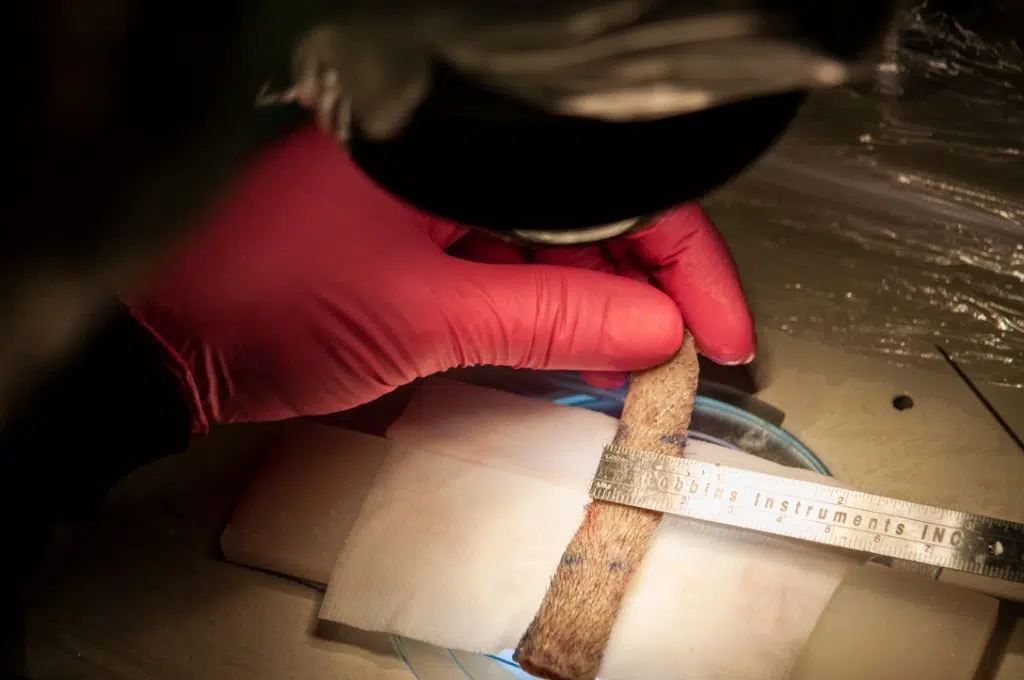In Follicular Unit Transplantation, often called FUT or strip hair transplant method, follicular unit grafts are essentially moved from one area of the body with an abundant supply of hair (the donor site) to the area where the hair is thinning or balding (the recipient area). Follicular unit transplantation is a highly effective and permanent solution for hair loss for suitable candidates.

The FUT Hair Transplant Procedure
Utilizing the strip harvest method in hair restoration surgery, which maximizes yield while minimizing scarring, Dr. Gabel will surgically remove the donor tissue from the back of the head in a single thin strip of a predetermined size. The donor hair is usually chosen from the back of the head because individual hair follicles are more densely packed they have the best long-term genetic stability to resist the effects of male pattern baldness. Dr. Gabel performs hair transplant procedures with meticulous detail and is careful to examine the donor hair for suitable grafts to transplant with expert precision.
Once the donor’s hair is mapped out, the hairs are trimmed to a length of approximately 8 mm. Dr. Gabel prefers the hairs to be a little longer so that he is able to see the natural curve of the hairs, which is important to know when placing the grafts aesthetically.
After this, the area that was mapped out and trimmed is numbed, and Dr. Gabel removes the designated donor strip of tissue. Dr. Gabel then closes up the donor area with sutures and a plastic surgery method called the trichophytic closure technique, designed to camouflage any potential scarring.
Following these steps, the donor strip is then carefully dissected into follicular units of hair under a microscope. These units may then be transplanted into the scalp in areas of thinning or balding. Dissecting the donor strip is one of the ways in which follicular unit extraction differs from follicular unit excision (FUE). In FUE surgical hair transplant procedures, the hair is removed from the donor site in sections small enough to be transferred.
In some cases, PRP may be utilized to encourage the transplanted hair to grow and accelerate healing. PRP, or platelet-rich plasma, is sourced from the patient’s own blood and encourages new cell growth and repair. Dr. Gabel may recommend other topical treatments to promote healing after the procedure as well.
Who is a Candidate for FUT Hair Transplants?
The typical follicular unit transfer candidate has thinning hair, a receding hairline, bald spots, or a combination of these. However, they also have a suitable amount of healthy hair in other areas, primarily in the back of the head, which can serve as the donor site.
It’s important that the candidate’s hair loss is not the result of stress, medication, medical treatment, or other condition which can be reversed before choosing surgery. It is also not ideal for those who have thinning hair or otherwise poor hair growth in the donor sites. Most FUT candidates are men suffering from male pattern baldness. However, the treatment is often suitable for women as well.
Another consideration for follicular unit transfer candidates is the length at which they wish to wear their hair. FUT is not ideal for patients who prefer to wear their hair very short, as scarring (while generally minimal) may be visible. For these patients, Dr. Gabel may suggest another procedure, such as follicular unit excision hair transplantation. In an FUE procedure, there is no long strip of hair taken from a donor site, but rather by extracting hair follicles individually throughout the scalp.
The Recovery Process After FUT Hair Transplant Surgery
Dr. Gabel and his team at the Gabel Center will provide detailed instructions on the post-operative care of the incision site after surgery. About 10 days after surgery, the sutures will be removed. Occasionally, Dr. Gabel will use absorbable sutures that do not need to be removed. The donor area will heal over the next several weeks resulting in a fine linear scar that blends underneath a patient’s existing hair.
After the procedure, you may experience some swelling around the forehead and hairline. Dr. Gabel will give you detailed directions, but generally, patients can wash their hair 24 hours after the procedure, use styling products 48 hours after, and can wear a hat immediately after if they choose.
Heavy lifting and exercises that place exertion upon the head and neck area to be avoided for several weeks after surgery, talk to Dr. Gabel about any specific concerns about your exercise regimens during your post-operative care. In particular, you will need to take care to avoid activities that stretch the back of the neck. The recovery process after FUT should take no more than two weeks.
